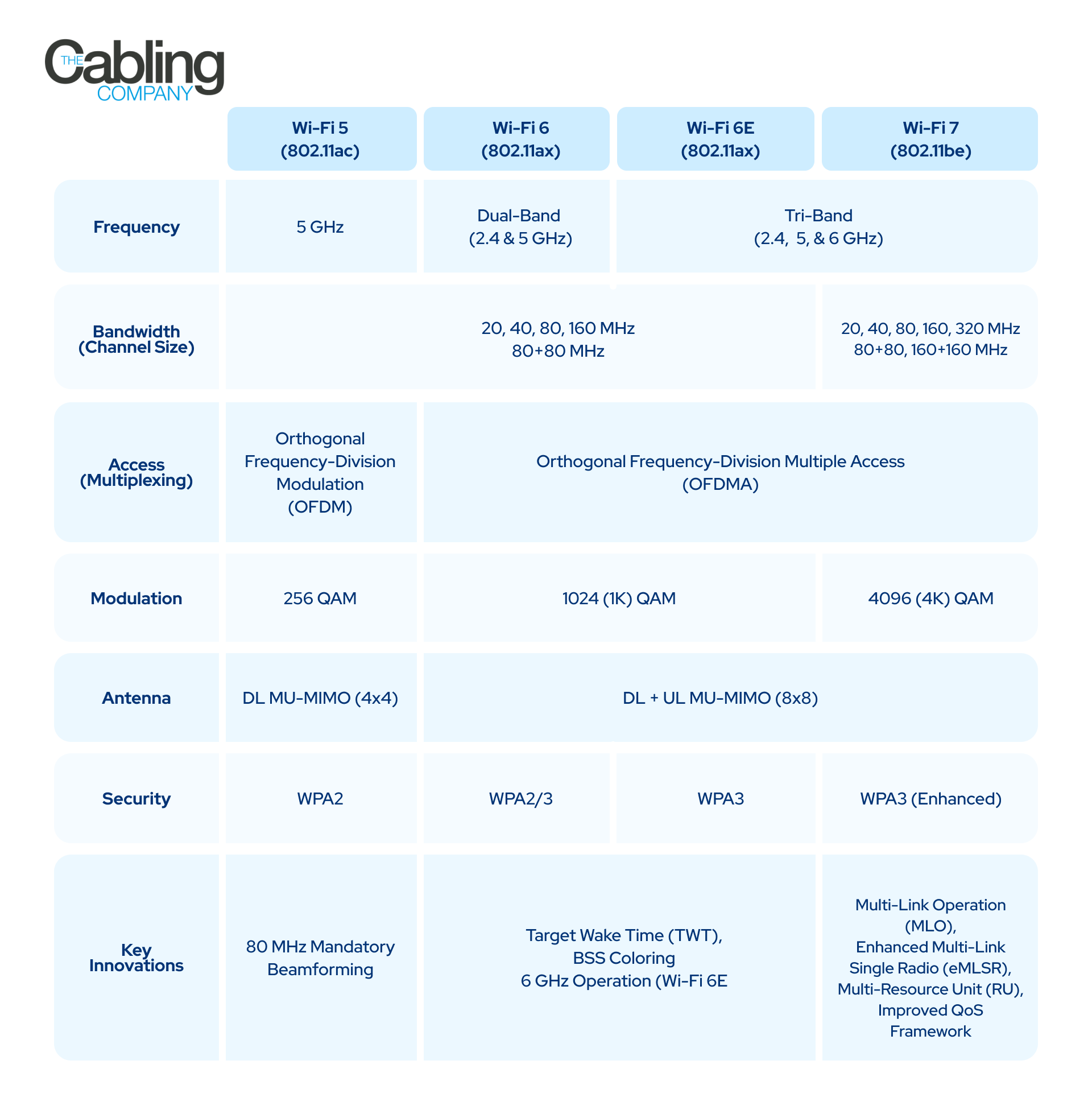Share this
Understanding WiFi 7: The new age of wireless
by Libby Jones on 09-Apr-2024 09:58:26
The next generation of Wi-Fi is here, and yes, it’s better than Wi-Fi 6E...
Wi-Fi has been a catalyst in keeping the globe connected, engaged, and efficient. With its constant evolution and groundbreaking innovations, the dawn of the next wireless era is here.
What's new?
Wi-Fi 7 features will enhance and advance beyond previous Wi-Fi generations, promising not just faster speeds but also significantly improved responsiveness and reliability. This will pave the way for more immersive consumer experiences and the integration of cutting-edge technologies in the future.
Elevated Standards
The advancements in Wi-Fi 7 will revolutionise responsiveness and consistency to unprecedented levels. Building upon the groundbreaking features of Wi-Fi 6 and Wi-Fi 6E, Wi-Fi 7 will not only deliver faster speeds but also enhance reliability and precision for upcoming applications that require unparalleled consistency.
320 MHz Channels
Wi-Fi 7 turbocharges speeds by cramming more data into every transmission. With 320 MHz channels doubling the size of previous Wi-Fi generations, the introduction of 4K QAM (Quadrature Amplitude Modulation) allows signals to densely pack even more data compared to the 1K QAM of Wi-Fi 6/6E.
A typical Wi-Fi 7 laptop can achieve an impressive maximum data rate of nearly 5.8 Gbps, which is 2.4 times faster than the 2.4 Gbps capability of Wi-Fi 6/6E. This significant speed boost not only enables seamless high-quality 8K video streaming but also reduces the download time of a massive 15 GB file to approximately 25 seconds, compared to the one minute it would take with older Wi-Fi technologies.
More reliable connections
Traditional Wi-Fi systems may offer access to various wireless bands, but devices typically stick to utilising only one band for transmitting data, switching to another band if necessary. However, with the introduction of Multi-Link Operation (MLO) in Wi-Fi 7, devices can now simultaneously connect on two bands. This not only enables faster speeds through data aggregation but also allows both bands to be used concurrently, sharing redundant or unique data to enhance reliability with ultra-low latencies and precision.

Is WiFi 7 worth the upgrade?
While Wi-Fi 7 routers are available for purchase, it's important not to rush into upgrading just yet. Only a limited number of devices currently support the standard, which is still in the process of being finalised. It may take some time for manufacturers to fully adopt Wi-Fi 7, so the true benefits of the new technology may not be fully realised at this early stage.
While the advancements in WiFi 7 are impressive, their reliability is only as strong as the cabling infrastructure that supports them. Investing in the latest WiFi 7 devices for your business is a great move, but it's crucial to also invest in an infrastructure that can handle the increased demand to fully reap the benefits of this cutting-edge technology.
Reinforcing your Infrastructure
As a company specialising in Data Cabling Projects, we have expanded our services to include Wi-Fi design ever since the emergence of Wi-Fi6 access points, followed by 6E and now Wi-Fi 7 AP’s. Over time, we have come to realise the critical role of well-designed cabling – both Copper and Fibre – which we believe is equally, if not more, essential than the hardware itself.
When upgrading your WIFI networks, make sure to prioritise installing or upgrading to Cat6a as the minimum standard for copper cabling. As well as this, you shouldn't overlook the importance of considering your fibre backbone link cables. Neglecting these crucial components could result in investing substantial time and money into the latest WIFI hardware without reaping any business benefits.
So what's the main takeaway? If WiFi 7 is right for your business, fully invest in a solution that ensures longevity and reliability for your network.
If you want to prepare for the latest WiFi rollout and fortify your business network infrastructure, contact our team for an expert design and installation consultation.
WiFi 7 FAQ's
With Wi-Fi 7, the evolving needs of individuals worldwide are being catered to, as each generation advances upon its predecessor. The key advantages of Wi-Fi, such as consistent ultra-low latency and enhanced performance in crowded settings, are anticipated to support emerging applications like 8K A/V Streaming, AR/VR, Cloud gaming, interactive programs, Industrial IoT and Industry 4.0, tele-diagnostics, and telesurgery.
Intel is gearing up to launch its lineup of Wi-Fi 7-certified products, set to hit the market in accordance with the Wi-Fi Alliance's certification timeline for 2023–2024.
Different countries offer varying Wi-Fi releases. Wi-Fi 4, Wi-Fi 5, Wi-Fi 6, and the emerging Wi-Fi 6E are widely accessible worldwide. The latest Wi-Fi 6E release, opening up the 6 GHz spectrum, is gaining rapid popularity and has already been embraced by numerous countries as of June 2022.
Share this
- Careers (5)
- The Cabling Company (4)
- Company News (3)
- Oxford United (3)
- 10 Years of TheCabling Company (2)
- Accreditations (2)
- CCTV (2)
- IP CCTV (2)
- Security Solutions (2)
- Wireless Network Design (2)
- AV (1)
- AV solutions (1)
- Access control (1)
- Audio Visual (1)
- CPR Regulations (1)
- Construction Products Regulation (1)
- Corporate (1)
- Health and Safety (1)
- Infrastructure (1)
- Meeting solutions (1)
- Service Level Agreements (1)
- WIFI6 (1)
- WiFi 7 (1)
- asset finance (1)
- cable leasing (1)
- framework agreements (1)
- smart security (1)
.png?width=200&height=79&name=The%20Cabling%20Company%20(1).png)
